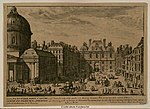Hermès
8th arrondissement of ParisBags (fashion)CAC 40Ceramics manufacturers of FranceClothing brands of France ... and 26 more
Clothing companies established in 1837Clothing companies of FranceComité Colbert membersCompanies in the Euro Stoxx 50Companies listed on Euronext ParisCosmetics brandsCosmetics companies of FranceDesign companies established in 1837Fashion accessory brandsFrench companies established in 1837Glassmaking companies of FranceHermès-Dumas familyHigh fashion brandsJewellery retailers of FranceLeather manufacturersLuggage brandsLuxury brandsManufacturing companies based in ParisManufacturing companies established in 1837Pages including recorded pronunciationsPerfume housesRetail companies established in 1837Retail companies of FranceShops in ParisWatch brandsWatch manufacturing companies of France
Hermès International S.A., or simply Hermès ( (listen) air-MEZ, French: [ɛʁmɛs] (listen)), is a French luxury design house established in 1837. It specializes in leather goods, lifestyle accessories, home furnishings, perfumery, jewelry, watches and ready-to-wear. Its logo, since the 1950s, is of a Duke carriage with horse. Nadège Vanhee-Cybulski is the current creative director.
Excerpt from the Wikipedia article Hermès (License: CC BY-SA 3.0, Authors).Hermès
Rue du Faubourg Saint-Honoré, Paris 8th Arrondissement of Paris (Paris)
Geographical coordinates (GPS) Address Nearby Places Show on map
Geographical coordinates (GPS)
| Latitude | Longitude |
|---|---|
| N 48.868933333333 ° | E 2.3217583333333 ° |
Address
Hermès
Rue du Faubourg Saint-Honoré 24
75008 Paris, 8th Arrondissement of Paris (Paris)
Ile-de-France, France
Open on Google Maps








